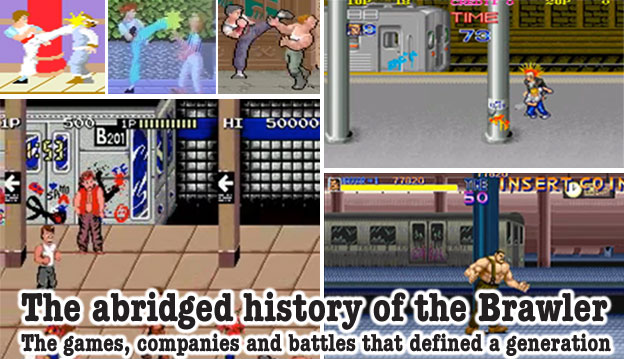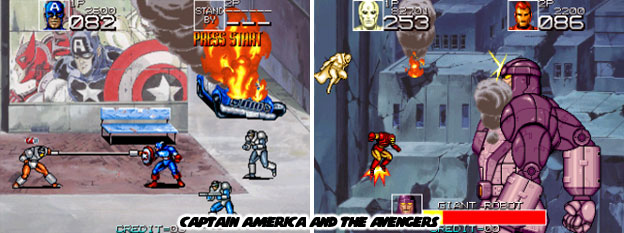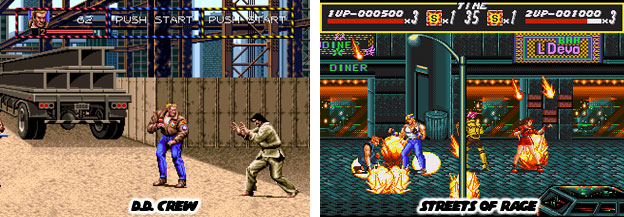
The start of the new decade, 1991, was a gold rush. Every arcade company wanted to make their fortune on a brawler. Data East saw the runaway success that Konami enjoyed with their licensed titles and decided to secure a high profile Western license for themselves as well. The result, Captain America and the Avengers, was without a doubt the biggest quarter-waster my brothers and I had the misfortune of playing.
The game featured Captain America, Iron Man, Vision and Hawkeye taking on the Red Skull and a collection of villains from Marvel Comics. Unfortunately the people at Marvel seemed to have little creative control once they signed up with Data East. The game played as if the Japanese developers flipped through some comic books in the lobby of Marvel studios and then never looked at them again. The character sprites were small and not detailed, possibly so players in the USA would not be offended by the gross disregard to the legendary designs. Playing as the characters was fun, I am not going to lie about that. Each character had ranged attacks and close up strikes. The first time I threw Captain America’s shield into the head of a robot and watched it bounce back to me I was quite giddy. I’ve enjoyed almost all of Data East’s arcade releases however this game left me disappointed.

The game ate quarters like mad. Every strike from rivals seemed to eat up health at an alarming rate. Quite honestly it probably ate quarters faster than P.O.W. Back then SNK had an excuse, the genre was just getting started. The line between difficulty for the sake of challenge and difficulty for the sake or ripping off players hadn’t been established yet. Data East had no excuse. Once they were out of health the characters would drop to their knees and exclaim “I can’t move…” at which point my brothers and I would yell out “Feed me another quarter!” The more time I spend talking about this game the more disappointed I get. So let’s move instead to another company that let me down and then redeemed themselves in the same year.
My friends know that I am passionate about Sega games, however D.D. Crew, the first traditional brawler from the publisher left me cold. Visually it was impressive. The size of the sprites, the level of detail and animations were pretty good. However watching Sega appropriate early Hip Hop culture and try to make a brawler “urban” and “street” was painful to watch, or rather listen to. The soundtrack consisted of an endless loop that sounded like a rip-off of a Whodini song with Tracy Morgan saying “Shut up already” over and over.
The game was as formulaic as it could be. There were four named characters, the buff King, the cool cop F.F., the black boxer Buster (possibly named after James “Buster” Douglas for which Sega had just released a Genesis game) and the elderly kung-fu master Gung Ho. They fought wave after wave of typical baddies on a way to fight yet another crime lord. The nonsensical phrases the bosses spouted off was laughable. There were two things I did enjoy with the game, the level set atop of a cable car which was great design. Too bad they had to fight a Bruce Lee clone. The other thing I enjoyed was being able to hurl opponents straight up in the air and watch them come crashing down a few seconds later. Other than that the game didn’t hold my attention, or the interest of the rest of the public for that matter. Sega managed to do far more for the genre in a game on a platform with less memory and processing power that same year.

Streets of Rage by most estimations, or at the very least the passionate Sega community, began the best console brawler series ever released. The variations on the formula were subtle but well executed. There were three playable characters, all undercover police officers and one of which was Blaze, a female cop. A strong female lead in a brawler hadn’t been seen since Tyris in Golden Axe. The three characters played more or less the same. Sega did not follow the conventions of having one being the slow strong one, the small fast one or one in the middle. Those character archetypes would be featured in the sequels.
Streets of Rage was a great game. The officers were on the trail of a crime lord. They had to beat up the gangs he controlled in order to get to him. The city was slightly futuristic and fairly original. I always felt that the rival designs were poached a bit much from Final Fight but it was still a great game. Where it innovated was in the use of crowd clearing moves. Players could earn special attacks which consisted of radioing for backup and having a cop car shoot a round of flaming mortar shells which rained down on opponents. This acted similarly to the magic spells in Golden Axe which affected all opponents on screen. By comparison Final Fight and other brawlers featured characters that could perform a crowd clearing move at the cost of some health points. I enjoyed the Sega mechanic much more.
1991 started out a bit rough for the arcades but things quickly improved. While not all the titles were winners, the majority were memorable. Sega showed that the arcade was no longer the exclusive domain of a great brawling experience. They managed to pick up where River City Ransom left off and brought the brawler into glorious 16-bit life at home . As for Capcom and Konami the rivalry to claim the title as greatest arcade developer would reach a fever pitch. The next blog will look at the single greatest year that both studios had in the arcade. As always if you enjoyed this blog and would like to sponsor me please visit my Patreon page and consider donating each month, even as little as $1 would help make better blogs and even podcasts!

Streets of Rage by most estimations, or at the very least the passionate Sega community, began the best console brawler series ever released. The variations on the formula were subtle but well executed. There were three playable characters, all undercover police officers and one of which was Blaze, a female cop. A strong female lead in a brawler hadn’t been seen since Tyris in Golden Axe. The three characters played more or less the same. Sega did not follow the conventions of having one being the slow strong one, the small fast one or one in the middle. Those character archetypes would be featured in the sequels.
Streets of Rage was a great game. The officers were on the trail of a crime lord. They had to beat up the gangs he controlled in order to get to him. The city was slightly futuristic and fairly original. I always felt that the rival designs were poached a bit much from Final Fight but it was still a great game. Where it innovated was in the use of crowd clearing moves. Players could earn special attacks which consisted of radioing for backup and having a cop car shoot a round of flaming mortar shells which rained down on opponents. This acted similarly to the magic spells in Golden Axe which affected all opponents on screen. By comparison Final Fight and other brawlers featured characters that could perform a crowd clearing move at the cost of some health points. I enjoyed the Sega mechanic much more.
1991 started out a bit rough for the arcades but things quickly improved. While not all the titles were winners, the majority were memorable. Sega showed that the arcade was no longer the exclusive domain of a great brawling experience. They managed to pick up where River City Ransom left off and brought the brawler into glorious 16-bit life at home . As for Capcom and Konami the rivalry to claim the title as greatest arcade developer would reach a fever pitch. The next blog will look at the single greatest year that both studios had in the arcade. As always if you enjoyed this blog and would like to sponsor me please visit my Patreon page and consider donating each month, even as little as $1 would help make better blogs and even podcasts!

No comments:
Post a Comment